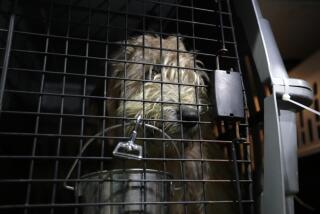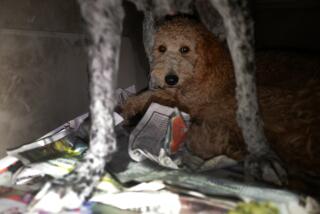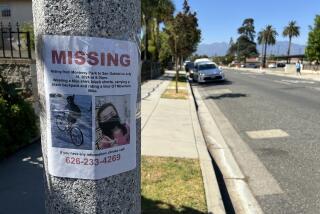Families of Missing Children Urge DNA Testing of Unclaimed Bodies
SACRAMENTO — On a June afternoon 12 years ago, Amber Swartz wandered outside to jump rope in the frontyard of her East Bay Area home. Fifteen minutes later, the 7-year-old in purple pants and sneakers was gone. There were no clues and no witnesses to explain why.
Since then, Amber’s mother has been haunted by the questions that burden all parents of the missing: What happened? Is my child still alive?
Kim Swartz believes answers may lie in county morgues, where the unidentified remains of more than 2,000 people--about 150 of them children--are stored.
A bill awaiting action by Gov. Gray Davis would create a database of DNA from the John and Jane Does and require state scientists to compare that material with samples from relatives of missing children and adults.
If signed into law by Davis, the bill would make California the first state to create a DNA database specifically to solve missing person cases. Backers say if it pays dividends here, they will push the concept across the nation.
“This could be a great help to traumatized families,” said Shirley Goins of the National Center for Missing and Exploited Children. “It could help them gain closure, grieve and move on with their lives.”
Swartz, who heads a missing children foundation named after her daughter, echoed that assessment. She said discovering that an abducted child is among the known dead--while horribly traumatic--would be far preferable to the gnawing ache of uncertainty.
“The endless wondering is one of the hardest things,” Swartz said. “If we do this DNA test and none of those [bodies] is her, then that gives me renewed hope that maybe she is alive somewhere.”
Results from the sampling also could provide investigators with new leads to track possible suspects in unsolved missing person cases, said state Sen. Jackie Speier (D-Hillsborough), author of the legislation, SB 1818. The state has more than 3,000 of those cases, some dating back 30 years.
“Law enforcement officials tell us that if we can identify a missing child’s remains as coming from a particular location, it will at least give them a place to begin looking for new clues,” Speier said.
A spokeswoman for the governor said he had not yet taken a position on the bill, which won broad bipartisan support in the Legislature. Swartz and other parents of abducted children have hand-delivered letters to Davis’ office, urging him to sign it.
Each year, California authorities investigate hundreds of reports of people abducted or missing under suspicious circumstances. So far this year, four people--two minors and two adults--have been reported abducted and an additional 1,866 were reported missing, statistics from the state Department of Justice show. Many of those cases were quickly resolved, but others continue to stump investigators.
Last week, mothers of some Bay Area missing children helped Speier publicize her bill during an event at the state’s DNA lab in Berkeley.
Among them was Ora Owens, whose son, Mitchell, was kidnapped from her San Mateo home in 1983 by an intruder who beat her. Also present was Joanne Rock of Millbrae, whose mentally ill grown son, Robert, wandered off five years ago without a trace.
Swartz was there, too. Since Amber’s abduction, detectives have fielded hundreds of tips and chased countless leads in their search for the nearly deaf girl with a speech impediment. Amber would now be 20, and her mother--who also has three sons--used her grief to launch the Amber Foundation for Missing Children in the family’s hometown of Pinole.
“Not a week goes by that we don’t receive some call or potential information relating to Amber’s case,” Swartz said. The abduction has been used as an FBI training tool and featured in books.
Swartz said she was shocked to learn that there are more than 2,000 unidentified remains in coroners’ lockers around the state. She believes many of the unidentified children were victims of abductions.
“If you think about it, you just don’t find a person dead somewhere--beside a road or wherever--and not think that a family is looking for them,” she said.
At the lab last week, the parents of missing children were set to become pioneers in the DNA testing program--if Davis signs Speier’s bill into law. Fighting back tears, they swabbed the insides of their cheeks with oversized Q-Tips and handed the cell samples to technicians, who will store them in test tubes.
The testing would be paid for with a $2 increase in the state’s $8 death certificate fee, raising $3 million a year for the next five years. The money would cover the purchase of additional equipment and the hiring of more scientists at the state lab, which is struggling to clear a backlog of more than 100,000 unanalyzed DNA samples from convicted felons.
Although experts say most relatives of the missing will rush to take advantage of the DNA testing, some may be reluctant. Goins, of the National Center for Missing and Exploited Children, said, “There will be some who do not want to relive this, who have gone on with their lives.” After all, “they know this won’t bring their child back.”
Swartz disagrees heartily with that perspective. And she’s urging all parents to take DNA samples of their children today, in case a tragedy occurs tomorrow. Scientists recommend one of the following procedures:
* Take a cotton swab of saliva from inside the child’s cheek, air dry, then freeze in a double layer of resealable plastic bags.
* Let a bloody bandage or baby tooth air dry, then freeze in the same manner.
* Keep nail clippings or hair strands with follicle attached in an envelope.
More to Read
Sign up for Essential California
The most important California stories and recommendations in your inbox every morning.
You may occasionally receive promotional content from the Los Angeles Times.










